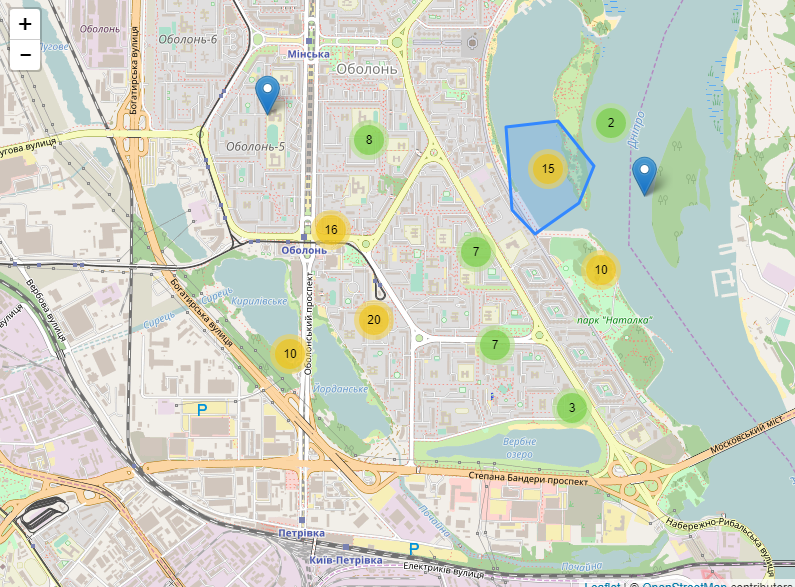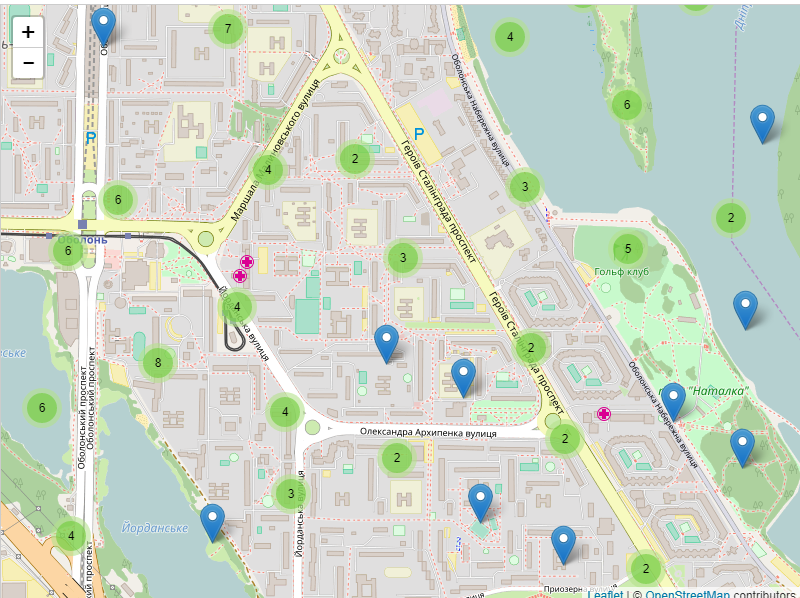谷歌地圖聚合點
我們有時候需要觀察地圖 不同地方數據的所在範圍和分布密集情況,熱力圖和聚合點的使用無疑是最好的選擇。
1.首先說說百度地圖,只做國內的地圖可以使用百度地圖的海量點和熱力圖還是蠻好用的。
a.海量點的最大好處是加載很多數據點的情況下不卡頓。
b.如果是畫mark在地圖上,當點多的時候,會很卡。
c.我之所以用谷歌地圖的熱力圖,是因為我發現百度地圖的熱力圖沒有疊加功能,滿足不了我的需求。比如說我想了解全國姓張,李,王的人的對比分布,我想要姓張的區域顯示紅色,姓李的顯示藍色,姓王的顯示橙色。這個需求百度地圖無法滿足我,但是谷歌可以。
2.說說谷歌地圖,谷歌地圖的熱力圖我就不說了,https://developers.google.com/maps/documentation/javascript/examples/ 這裏面有實例的。
a.谷歌地圖支持熱力圖疊加,但是沒有海量點,這一點讓我很難過,如果全部畫marker的話,數據點太多,加載太卡
b.這就用到了谷歌聚合點,如圖


3.代碼實例,主要看看引用了哪些個文件,我是從 https://github.com/Leaflet/Leaflet.markercluster 找到的下載包和實例
<!DOCTYPE html>
<html>
<head>
<title>Leaflet debug page</title>
<link rel="stylesheet" href="https:[email protected]
<script src="https:[email protected]/dist/leaflet-src.js" integrity="sha512-WXoSHqw/t26DszhdMhOXOkI7qCiv5QWXhH9R7CgvgZMHz1ImlkVQ3uNsiQKu5wwbbxtPzFXd1hK4tzno2VqhpA==" crossorigin=""></script>
<meta name="viewport" content="width=device-width, initial-scale=1.0">
<link rel="stylesheet" href="screen.css" />
<link rel="stylesheet" href="../dist/MarkerCluster.css" />
<link rel="stylesheet" href="../dist/MarkerCluster.Default.css" />
<script src="../dist/leaflet.markercluster-src.js"></script>
</head>
<body>
<div id="map"></div>
<button id="populate">Populate 1 marker</button>
<button id="remove">Remove 1 marker</button>
<script type="text/javascript">
var tiles = L.tileLayer(‘https://{s}.tile.openstreetmap.org/{z}/{x}/{y}.png‘, {
maxZoom: 18,
attribution: ‘© <a href="https://www.openstreetmap.org/copyright">OpenStreetMap</a> contributors‘
}),
latlng = new L.LatLng(50.5, 30.51);
var map = new L.Map(‘map‘, {center: latlng, zoom: 15, layers: [tiles]});
var markers = new L.MarkerClusterGroup();
var markersList = [];
function populate() {
for (var i = 0; i < 100; i++) {
var m = new L.Marker(getRandomLatLng(map));
markersList.push(m);
markers.addLayer(m);
}
return false;
}
function populateRandomVector() {
for (var i = 0, latlngs = [], len = 20; i < len; i++) {
latlngs.push(getRandomLatLng(map));
}
var path = new L.Polyline(latlngs);
map.addLayer(path);
}
function getRandomLatLng(map) {
var bounds = map.getBounds(),
southWest = bounds.getSouthWest(),
northEast = bounds.getNorthEast(),
lngSpan = northEast.lng - southWest.lng,
latSpan = northEast.lat - southWest.lat;
return new L.LatLng(
southWest.lat + latSpan * Math.random(),
southWest.lng + lngSpan * Math.random());
}
markers.on(‘clusterclick‘, function (a) {
alert(‘cluster ‘ + a.layer.getAllChildMarkers().length);
});
markers.on(‘click‘, function (a) {
alert(‘marker ‘ + a.layer);
});
populate();
map.addLayer(markers);
L.DomUtil.get(‘populate‘).onclick = function () {
var bounds = map.getBounds(),
southWest = bounds.getSouthWest(),
northEast = bounds.getNorthEast(),
lngSpan = northEast.lng - southWest.lng,
latSpan = northEast.lat - southWest.lat;
var m = new L.Marker(new L.LatLng(
southWest.lat + latSpan * 0.5,
southWest.lng + lngSpan * 0.5));
markersList.push(m);
markers.addLayer(m);
};
L.DomUtil.get(‘remove‘).onclick = function () {
markers.removeLayer(markersList.pop());
};
</script>
</body>
</html>
谷歌地圖聚合點
